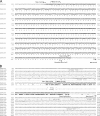Genetic basis for the new pneumococcal serotype, 6C
- PMID: 17576753
- PMCID: PMC1951153
- DOI: 10.1128/IAI.00510-07
Genetic basis for the new pneumococcal serotype, 6C
Abstract
We have recently reported a new pneumococcal serotype (6C), which is closely related to serotype 6A (I. H. Park et al., J. Clin. Microbiol. 45:1225-1233, 2007). To investigate the genetic basis for serotype 6C, we studied the capsule gene loci of 14 6C isolates from three different continents, including one isolated in Alabama 27 years ago. The wciN region of all 6C isolates has a 1,029-bp-long sequence that replaces the 1,222-bp-long sequence of the 6A wciN region. This recombination event has created a new 1,125-bp-long open reading frame which encodes a product that is also homologous to glycosyl transferases. Flanking this introduced gene is 300 bp upstream and 100 bp downstream with only about 90% homology with 6A and which is identical in all 6C isolates. Transfer of the wciN region converts 6A to 6C. Determination of the DNA sequence of the entire capsule gene locus of one 6C isolate showed that the 6C capsule gene locus is almost identical (>98% homologous) to that of 6A except for the wciN region. These findings indicate that the 6C capsule type originated more than 27 years ago by a single recombination event in a 6A locus in which 6A wciN was replaced by a gene of unknown origin.
Figures





Comment in
-
Low prevalence of recently discovered pneumococcal serotype 6C isolates among healthy Dutch children in the pre-vaccination era.Vaccine. 2008 Jan 24;26(4):449-50. doi: 10.1016/j.vaccine.2007.11.026. Epub 2007 Dec 3. Vaccine. 2008. PMID: 18093702 No abstract available.
References
-
- Bentley, S. D., D. M. Aanensen, A. Mavroidi, D. Saunders, E. Rabbinowitsch, M. Collins, K. Donohoe, D. Harris, L. Murphy, M. A. Quail, G. Samuel, I. C. Skovsted, M. S. Kaltoft, B. Barrell, P. R. Reeves, J. Parkhill, and B. G. Spratt. 2006. Genetic analysis of the capsular biosynthetic locus from all 90 pneumococcal serotypes. PLoS Genet. 2:e31. - PMC - PubMed
-
- Bolotin, A., B. Quinquis, P. Renault, A. Sorokin, S. D. Ehrlich, S. Kulakauskas, A. Lapidus, E. Goltsman, M. Mazur, G. D. Pusch, M. Fonstein, R. Overbeek, N. Kyprides, B. Purnelle, D. Prozzi, K. Ngui, D. Masuy, F. Hancy, S. Burteau, M. Boutry, J. Delcour, A. Goffeau, and P. Hols. 2004. Complete sequence and comparative genome analysis of the dairy bacterium Streptococcus thermophilus. Nat. Biotechnol. 22:1554-1558. - PMC - PubMed
-
- Coffey, T. J., C. G. Dowson, M. Daniels, J. Zhou, C. Martin, B. G. Spratt, and J. M. Musser. 1991. Horizontal transfer of multiple penicillin-binding protein genes, and capsular biosynthetic genes, in natural populations of Streptococcus pneumoniae. Mol. Microbiol. 5:2255-2260. - PubMed
Publication types
MeSH terms
Associated data
- Actions
- Actions
- Actions
- Actions
- Actions
Grants and funding
LinkOut - more resources
Full Text Sources
Other Literature Sources

